This article first in the American Orchid Society BULLETIN in November of 1956 as part of a multi-part handbook. It has been edited to conform with modern nomenclature.
FROM THE TIME OF ITS INTRODUCTION into cultivation, more than a century ago, this lovely orchid has won the favor of orchid growers, but for many years its culture was deemed extremely difficult, healthy, vigorous specimens being rare in horticulture. How different it is today is evident as one visits orchid hobbyists and commercial growers throughout the country, for it is a rare collection that does not possess a few of these beauties, strong robust plants which dispel the legend of delicacy attributed to them. In fact, Phalaenopsis has become an important cut-flower crop, with large, heavy-substance flowers possessing unusual long-lasting qualities. Part of this change is due to new methods of culture, particularly in the matter of light and feeding, while developments in breeding and the influence of polyploidy have also made major contributions. At any rate, Phalaenopsis is no longer an orchid to challenge the master grower but is now an accepted orchid for the beginner.
The Genus
History: although the genus Phalaenopsis was established by Dr. Karl Lud-wig Blume, the Dutch botanist, in 1825, and plants were introduced into English cultivation in 1833, the history of this interesting group of orchids goes back almost another hundred years. The earliest published account of a member of this genus was by Rumphius in the sixth volume of his HERBARIUM AMBOINENSE in 1750, wherein he described and figured a plant which he had found growing on the island of Amboina and which he called "Angraecum album majus." Two years later it was discovered in Java by Osbeck, who preserved some specimens which were forwarded to Linnaeus. In 1753, in his first edition of SPECIES PLANTARUM, Linnaeus described it as Epidendrum amabile, for his genus Epidendrum was appropriate for epiphytic orchids which, at that time, were few in number. Swartz, in 1799, broke up the genus Epidendrum into six genera but, although noting that this orchid differed from other epidendrums in the attachment of the lip to the column, he allowed it to remain as Linnaeus had assigned it. Later, Roxburgh transferred the species to Swartz's genus Cymbidium, to which it is more closely related, but it remained for Dr. Blume to establish the new genus Phalaenopsis in his BIJDRAGEN in 1825 to accept this fascinating orchid. He derived the generic name from the Greek phalaina "a moth," and opsis, "appearance," because of the fancied resemblance of the flowers to white moths in the tropical jungles.
The first plant introduced into cultivation in Europe was sent from Manila by Hugh Cuming in 1837. This was mistaken for the true Phalaenopsis amabilis and was so named. Subsequently in 1847, Thomas Lobb introduced the true Phalaenopsis amabilis but Dr. Lindley, noting its differences from the plant sent by Cuming and not recognizing it as the Phalaenopsis amabilis of Blume, named it Phalaenopsis grandiflora, the error persisting for many years despite numerous published corrections.
Since then, numerous species have been found and described, many forms appearing under various names, until literature has recorded more than 230 names. Of this number, many are synonyms while others have been placed in new or different genera at various times, according to the interpretations of successive taxonomists.
The first comprehensive treatment of the genus was by Reichenbach in the second volume of his XENIA ORCHIDACEAE, published in 1874. Here eleven species were enumerated, although more were known at that time. Many additions were made in the following decade, so that when Robert A. Rolfe published his "Revision of the Genus Phalaenopsis" in the GARDENERS' CHRONICLE for 1886, he described thirty-four distinct species with numerous varieties, including two presumed natural hybrids. More additions were made. Rolfe, in the ORCHID REVIEW for 1905, published "Notes on the Genus Phalaenopsis" with several new forms included, while J. J. Smith described a new Phalaenopsis in 1933 and Miwa as late as 1941. Additional new members of the genus will probably be discovered before the record for this genus is permanently closed. (Editor's note: The World Checklist of Monocotyledons current (2010) recognizes 61 species, numerous subspecies and seven natural hybrids.)
Bentham separated the genus Phalaenopsis into two sections, the Euphalaenopsis to include Phalaenopsis amabilis and its allies, and the Stauroglottis based on Phalaenopsis equestris and its allies. Rolfe, in his revision of the genus, established two new sections: Proboscidioides containing only the one species, Phalaenopsis lowii, and Esmeraldae accommodating the concepts of Reichenbach, Phalaenopsis esmeralda and Phalaenopsis antennifera. But Rolfe finally, in the ORCHID REVIEW for 1917, reported that the Phalaenopsis esmeralda of Reichenbach was the long-lost Doritis pulcherrima of Lindley and Phalaenopsis antennifera was just a slight variation of the same thing. At the same time, Rolfe established a new genus Kingiella to accommodate the other species of so-called Doritis which had been previously removed from the genus Phalaenopsis. (Editor's note: Doritis, Kingidium and Kingiella have all now been reduced to synonymy with Phalaenopsis, however the terete-leaved species have been segregated to the genus Paraphalaenopsis.).
Botanical description: the description of the genus is dependent upon the members which are included and excluded. Though there is a fairly broad base of common characters, there is such a range of characters not shared by all or most of the species that sharp delimitation is impossible. The following constitutes a necessarily broad but reasonably precise summary of the genus.
Plant epiphytic on trees and rocks, with monopodial growth; stems short with few to several leaves borne closely together. Leaves generally persistent, somewhat fleshy or leathery, green or mottled, broad, flat and drooping. Inflorescence lateral from near the base of the stem, short or long, drooping, arching or erect, simple to branching, bearing from few to many flowers. Flowers small to rather large, of various colors, usually showy and long-lasting. Sepals similar and nearly equal, spreading. Petals similar to sepals, slightly narrower or much broader. Lip three-lobed, joined to the column foot without a hinge, variable and complex with antenna-like appendages usually present. Column short to elongate, with a prominent foot. Anther terminal, incumbent, two-celled. Pollinia two, waxy, subglobose or ovoid, somewhat cleft, on a fairly long stipe.
Since the sectional division of the genus will likewise depend on the species retained, the sections of Phalaenopsis have no great import for horticulturists. Most of the useful species are found in the Subgenus Phalaenopsis, sections Phalaenopsis, Esmeraldae and Stauroglottis. Species from the different sections do hybridize, and it is evident that future breeding will use several species which are now regarded almost as curiosities.
Allied genera: Phalaenopsis is a member of the Subtribe Sarcantheae, along with about eighty other genera. It is related to Vanda and for additional information, the reader is referred to the BEGINNERS' HANDBOOK which appeared in the September, 1956, issue of the AMERICAN ORCHID SOCIETY BULLETIN.
Phalaenopsis is rather easily distinguished from the other popular members of the Sarcantheae by its habit, the few leaves being fairly broad, flat and closely borne on a short stem; occasionally, however, vigorously grown plants will retain up to fourteen or more leaves, the internodes becoming long and the plant bearing a marked resemblance to a broad-leaved Vanda. The flowers do not have the distinct spur at the base of the lip as in Vanda, Aerides, Rhynchostylis, Ascocentrum, Saccolabium and Angraecum. Phalaenopsis has but two pollinia, while Arachnis, Renanthera, Trichoglottis and Vandopsis have four.
In a manner of speaking, Phalaenopsis represents a connecting link between Arachnis or Renanthera and Vanda, in flower structure. The plant habit is quite distinctive, not being duplicated in any other major genus.
Geographical distribution: Phalaenopsis is a widespread genus ranging from Assam and the Eastern Himalayas to Burma, the Andaman Islands, Malaya, Indonesia, Borneo, the Moluccas and Philippine Islands. This is a more restricted but similar distribution as that of Vanda and Aerides, which extend also over much of the highlands of India. Within this area, the species are fairly well confined to certain regions or even a single locality. The Philippine Islands represent the primary center with about fifteen species and natural hybrids. Borneo has more than a half-dozen, several of which are known nowhere else. Phalaenopsis parishii, however, is found from South India and Ceylon through Burma and Malaysia to the Philippines. Phalaenopsis mannii is confined to a small area of Assam, somewhat removed from its allies, at higher elevations than is known for the other species of the genus.
While some of the species of Phalaenopsis do grow at sea level and others at much higher elevations, the general climatic conditions under which they grow are relatively uniform, the seasonal variation being more in respect to rain than to temperature or day length. They show a distinct preference for shade in their native habitats, plants growing in deep shade being far more robust than those in bright sun.
List of species: although the genus contains some 60 or more species, depending on taxonomic viewpoint, a significantly smaller number are commonly found in cultivation. Among hybridizers, however, there is a gradual awakening to the potentialities of the lesser known species. The search for new forms, colors and patterns in hybrids has directed attention to such species as Phalaenopsis mannii, P. lueddemanniana, P. equestris, P. parishii, P. pulcherrima and others. Eventually a number of others will be utilized.
Subgenus Phalaenopsis Section Phalaenopsis with their broad-petaled flowers, are the species in the background of most of today's modern white and pink-flowered hybrids and include Phalaenopsis amabilis, P. aphrodite, P. x leucorrhoda, P. schilleriana and P. sanderiana.
Section Stauroglottis includes P. equestris and P. lindenii.
The section Esmeraldae includes the same species as when considered a separate genus, P. pulcherrima, P. buysonniana, and P. regnieriana.
Subgenus Polychilos Section PolychilosPolychilos includes a close-knit group including P. mannii, and P. cornu-cervi.
Amboinenses contains perhaps the largest group of species and includes P. fasciata, P. fimbriata, P. maculata, P. bellina, P. violacea, P. lueddemanniana, P. luteola, P. mariae, and P. micholitzii.
Section Zebrinae include such species as P. inscriptiosinensis, P. speciosa, P. tetraspis, P. corningiana, and P. sumatrana.
Several species are quite distinctive and without close allies. Phalaenopsis lowii is one such very distinct species and has been placed in Subgenus Proboscidioides. Phalaenopsis appendiculata, P. parishii and the very closely related P. lobbii form a cohesive group of species placed in Subgenus Parishianae.
From a cultural point of view, the species of Phalaenopsis have fairly similar requirements and hence no cultural division of the genus is necessary.
Blooming habits: as a rule, some kind of Phalaenopsis is in bloom at any time of the year. However, the members of the section Phalaenopsis generally bloom from late summer through winter into spring, with the peak in winter and spring, although the hybrids are far less seasonal and tend to bloom in varying degree throughout the year. Phalaenopsis lueddemanniana has a rather indeterminate blooming period, while P. parishii, P. sumatrana, P. lowii and P. violacea generally bloom in summer.
Since Phalaenopsis has a monopodial manner of growth, the flower spikes can be produced at any time without regard to the maturity of the new growth. The inflorescence arises from the base of the leaves and continues to grow in some species as flowers are produced in succession. In other species all the flowers on the stem open at the same time. The inflorescence may be branched or unbranched. When the rachis is unbranched, the flowers are usually produced in two rows, but sometimes the flowers are scattered in all directions, or arranged spirally.
White and pink Phalaenopsis are brought into flowering by cooler day and night temperatures. They appear not to be influenced by day or night length with regard to setting spikes. Day temperatures in excess of 82F or significant periods or night temperatures above 77F inhibit flowering. Summer blooming species tend not to be as influenced by temperature. Dr. Gavino Rotor, Jr., has found that in Phalaenopsis amabilis, continuous short days at 65F stimulated flowering and caused the development of new inflorescence stalks and lateral flowering branches so that continuous flowering resulted. Long days did not prevent flowering but reduced the flowering period to once a year. Dr. Rotor found that Phalaenopsis schilleriana at 65F was similarly affected by short days so that plants flowered two or more times a year. Long days did not entirely prevent flowering but did tend to produce vegetative shoots from stalks produced in the summer. Stalks which first emerged in early fall, however, came into bloom in December and January.
General culture: as a rule, Phalaenopsis come from the lower altitudes of areas in the tropical or north tropical zone, where temperatures are fairly uniform, the daytime temperature not excessive, the nights seldom cool, with relatively little temperature changes from season to season. The main seasonal variation is rain, for after the heavy rainy season during which time the plants flower, an excessively dry season follows. "Dry" season only means "rainless" season, for the air remains heavy with moisture and the cool mornings leave the plants soaked with dew. The healthiest plants grow in the shade, again a factor which moderates the temperature, while strong winds are not uncommon. From this sketch of natural conditions, we can lead into good cultural practice for greenhouse growing.
The recommended temperature range is from 65F at night to 80F in the day. The daytime temperature may rise considerably higher without harm. Seedlings may be grown about five degrees higher. Some successful growers grow their mature plants at this warmer range during the summer months, until the plants prepare to flower in October, when the temperature is dropped to the lower figure.
Phalaenopsis do not require a great deal of light, approximately 1000 foot-candles being sufficient. Cheesecloth, Aluminet or saran cloth can be used as shade inside a greenhouse over your Phalaenopsis if they are grown with other orchids. In the winter, when days are shorter and the sun at a lower angle, the shading can be decreased to allow a maximum of about 1500 foot-candles on the brightest day.
The plants should be kept moist. Do not keep them wet, but the medium should never be allowed to completely dry out. Be careful not to have water remain on the leaves or in the leaf axils overnight. During the day a high humidity must be maintained, with about 70% minimum and higher if the temperature rises from sun heat beyond the limit of 80F The humidity should be less at night, especially when plants are in flower.
Phalaenopsis demand good air movement. Ordinary ventilation in many areas would be too drying, although outside ventilation is recommended whenever it can be supplied without reducing the humidity below the minimum. In warm, humid areas such as the coastal areas of Florida or Hawaii, Phalaenopsis may be grown outside under lath or shaded by trees, and here the natural air movement is fine. In greenhouses in areas where outside air is dry, it is better to maintain humidity and secure air movement through the use of circulator fans.
Osmunda has been the standard potting medium for Phalaenopsis and tree fern has been widely used (now virtually impossible to find the former and potting mixes suitable for other epiphytic orchids can easily be used for Phalaenopsis culture). However, organic mixes of redwood fiber or similar composts designed for Cymbidiums will be good for seedlings. Mature plants are readily adaptable to hydroponic culture in gravel. The roots are tender and fleshy, hence great care must be exerted not to damage the roots when repotting. The organic mixes make potting very simple and reduce root damage.
In bark or inorganic media, Phalaenopsis should be fed regularly. A dilute chemical fertilizer is most frequently used, although fish emulsion, dilute manure water and similar fertilizers have been used with success. It is important that plants are not overfed, and fertilizer should be extremely dilute. For plants grown in moss, less fertilizer should be used since the moss has a strong tendency to retain fertilizer salt.
Baskets are highly popular for Phalaenopsis among growers who hang their plants from the roof or from pipe racks along the wall. When the plants are grown on benches, shallow pots or pans are preferred. Drainage must be very good.
SPECIES OF PHALAENOPSIS
Phalaenopsis alboviolacea: (= Phalaenopsis deliciosa subsp. deliciosa)
Phalaenopsis amabilis
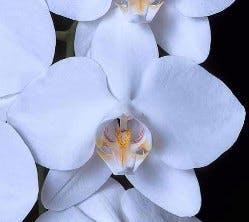
Widespread from Sumatra and Java to the southern Philippines, New Guinea and Queensland. This, the first species known to science and the type species for the genus, was originally collected on the island of Amboina by Rumphius who described it under the name Angraecum album majus in his HERBARIUM AMBOINENSE in 1750. Two years later, Osbeck discovered it on New Island at the western end of Java, and specimens prepared by him were sent to Linnaeus who described the species as Epidendrum amabile in the first edition of his SPECIES PLANTARUM, published in 1753. It was introduced into the East India Company's botanic garden in Calcutta in 1798, so that Roxburgh included it in his FLORA INDICA although he transferred the species to the genus Cymbidium. It appeared in several accounts of collectors during the following years, until detected by Dr. Blume who founded the new genus Phalaenopsis upon it in 1825. It was introduced into cultivation in 1846 but became widely known as Phalaenopsis grandiflora through an oversight on the part of Lindley. The leaves are broadly obovate, from six to twelve inches long or larger, leathery to somewhat fleshy, deep glossy green. The inflorescence varies in size, is usually arching and either simple or branched, bearing many flowers. The flowers are three to four inches across, the sepals and petals white, the dorsal sepal elliptic, the lateral sepals lanceolate and slightly oblique. The petals are very broad, nearly rounded, but contracted at the base. The lip is three-lobed, the side lobes curved inward and yellow with red spots on the narrowed base, the front lobe hastate with two auricles at the base and two curving tendrils at the apex. The two-lobed crest is yellow spotted with red. The column is short. This species is widely distributed in its native habitat and is prominent in horticulture. The bulk of the hybrid Phalaenopsis have Phalaenopsis amabilis in their background, while the fine white hybrid Phalaenopsis of today are almost entirely made of selected forms of this species or its very close allies. There are several named varieties of this species but in many cases such var. rimestadiana (now considered synonymous with Phal. amabilis the differences are either insignificant or unclear. Two clear variants are subsp. rosenstromii (endemic to New Guinea and Queensland) and var. aurea (differs from the type by a yellow lip midlobe). A close ally, Phalaenopsis aphrodite from the northern Philippines and southeastern Taiwan, has often been confused with Phal. amabilis or considered a variety, modern taxonomists now recognize them as clearly distinct species. This is a fine, vigorous and easily adapted plant for the beginner, grown moderately warm for best results.
Phalaenopsis ambigua: ( = Phalaenopsis aphrodite subsp. aphrodite)
Phalaenopsis amethystina: ( = Phalaenopsis deliciosa subsp. deliciosa)
Phalaenopsis antennifera: ( = Phalaenopsis pulcherrima)
Phalaenopsis aphrodite
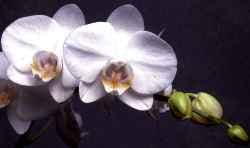
The northern Philippines and southeastern Taiwan (the latter a distinct subspecies; subsp. formosana. This is the Philippine form of Phalaenopsis amabilis and has been regarded as a varietal form although the two species are clearly recognized as distinct today. The elliptic-oblong leaves are up to fifteen inches long and three and one-half inches broad, uniformly deep green above and purplish beneath. The inflorescence is up to three feet long, arching, either simple or branched, green with purple mottling, bearing numerous to many flowers. The flowers are smaller than those of Phalaenopsis amabilis, usually about two and one-half to three inches across or occasionally slightly larger. The sepals and petals are white, frequently with a delicate flush, the dorsal sepal being oblong, the lateral sepals ovate-falcate, and keeled in back. The petals are rhomboidal with a narrowed claw, about twice as broad as the sepals. The three-lobed lip is stained with yellow and marked with purple at the base and along the base of the side lobes. The side lobes are broadly oval, curved inwardly, the front lobe is hastate with two tendrils at the apex. The crest is bilobed, the apices of the lobes toothed, yellow spotted with red. The column is short, white and terete; the anther is beaked. This is the first of the Phalaenopsis species to be introduced alive and to flower in cultivation, after being sent from Manila by Hugh Cuming in 1837. Lindley mistook it for the Phalaenopsis amabilis of Blume, and thus the Philippine species has been commonly grown under the latter name, one of the sources of confusion in this group. This is another species with many old named varieties although with the exception of subsp. formosana and aphrodite, these are now considered synonymous with Phal. aphrodite or species in their own right. In many ways, Phalaenopsis aphrodite is more beautiful than Phalaenopsis amabilis, the flowers being fuller although somewhat smaller. There is little doubt that in some of the hybrids in this genus, the actual species used has not always been correctly identified, resulting in some erroneous conclusions on breeding. This species is worth the attention of the hobbyist, blooming in autumn and winter.
Phalaenopsis sanderiana
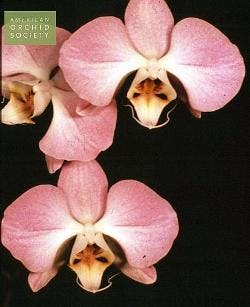
Endemic to the Phillipines This fairly pink species used to be considered a varietal form of Phal. aphrodite or a natural hybrid between Phalaenopsis aphrodite and Phalaenopsis schilleriana. Modern taxonomists are now in agreement that this is a species in its own right. Flowers are typically smaller than either amabilis or aphrodite and are white with varying degrees of pink overlay near the edges of the sepals and petals. This species, unlike the others in the section, tend to bloom off-season, in mid to late summer.
Phalaenopsis appendiculata
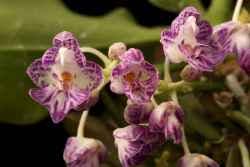
Endemic to Malaysia. A small-flowered species described by Carr in the GARDEN BULLETIN OF THE STRAITS SETTLEMENT in 1929, it is a dwarf plant and until rather recently unknown in cultivation. Recently a couple of plants have been recognized with AOS awards. Its patterned flowers and dwarf habit suggest it might be quite useful in modern novelty breeding lines.
Phalaenopsis bella: (= Phalaenopsis deliciosa subsp. deliciosa)
Phalaenopsis bellina
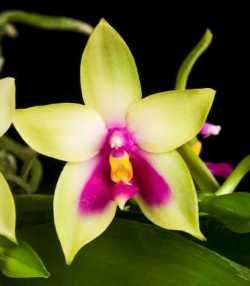
Malaysia and Sarawak. This species has long been considered synonymous with Phal. violacea often referred to as the "Borneo" type. True Phal. violacea bears flowers completely suffused with purple, leaving no more than the sepal and petal apices green while Phal. bellina has green or green-white flowers. In this species the purple suffusion is confined to the lateral sepals, the very bases of the dorsal sepal and petals, lip and column. In addition, the two species have distinctly different floral odors; that of Phal. violacea is distinctly spicy while the fragrance of Phal. bellina is often described as that of the cereal Fruitloops. Phalaenopsis bellina may well be the most fragrant species in the genus.
Phalaenopsis boxallii (= Phalaenopsis mannii)
Phalaenopsis buyssoniana
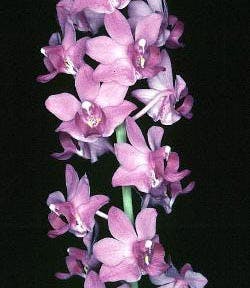
Thailand and Indochina. This species has often been considered synonymous with Phal. pulcherrima or, at best a varietal form. However, Phal. buysonniana has been found to have 76 chromosomes while Phal. pulcherrima has only 38. While this might suggest that Phal. buysonniana is nothing more than a spontaneous tetraploid variant of the latter, colchine-treated tetraploid conversions of Phal. pulcherrima have proven not to look at all like Phal. buysonniana. The flowers of this species are pale pink with little variation in color intensity.
Phalaenopsis x casta: Philippines. A presumed natural hybrid between Phalaenopsis aphrodite and Phalaenopsis schilleriana, and hence a synonym of Phalaenopsis x leucorrhoda.
Phalaenopsis cornu-cervi
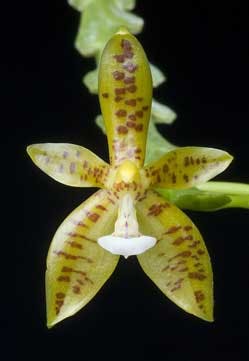
Northeast India to Burma, Malaya, Java and Borneo. This interesting species was first described as i>Polychilos cornu-cervi by Breda in his GENERA ET SPECIES ORCHIDACEARUM in 1827, and subsequently transferred to Phalaenopsis by Blume and Reichenbach in the HAMBURGER GARTENZEITUNG for 1860. It is a curious species with the rachis of the inflorescence flattened like a stag's horn, hence its name. The oblong leaves, up to ten inches long, are leathery and bright, glossy green. The inflorescence is nearly erect, the rachis flattened, bearing up to twelve flowers along the distal half. The flowers are up to two inches across, expanding in succession so that only a few are open at one time. The sepals and petals are spreading, elliptic-oblong and pointed, yellow-green barred and blotched with red-brown, the petals slightly narrower than the sepals, the lateral sepals being somewhat falcate and keeled behind. The lip is shorter than the other segments, three lobed, white, the side lobes erect, the front lobe crescent-shaped with a bearded callus at the base. Not common in cultivation, it is a decidedly interesting species for the collector. The blooming season is varied.
Phalaenopsis corningiana
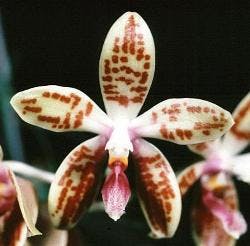
Endemic to Borneo. This species is rare in cultivation and there have been repeated misidentifications of Phal. sumatrana as Phal. corningiana in cultivation. Floral fragrance is perhaps the best way to separate these two closely related species; especially if they are very heavily pigmented. Phalaenopsis corningiana has flowers with a pleasant candy-like fragrance while the fragrance of Phal. sumatrana is a somewhat unpleasant acrid odor. The third species in this close-knit group is Phal. inscriptiosinensis (endemic to Sumatra) which differs from the first two in having a lip midlobe devoid of hairs.
Phalaenopsis deliciosa subsp. deliciosa
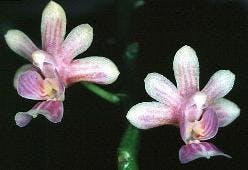
India, Ceylon, Burma, Malaysia and Philippines. A variable and very widespread species, it belongs to that group which Rolfe separated into the genus Kingiella. The original description by Griffith in his NOTULAE referred it to Aerides but in 1947 Holttum restored the Kingiellas to the genus Phalaenopsis. The rather thin leaves are about five inches long and one and one-half inches broad with a slender upright to nodding inflorescence seldom as long as the leaves. The flowers are small with white sepals and petals, the lateral sepals spotted with purple at the base. The lip is longer than the other segments, slightly saccate at the base, three-lobed and complex, purple. Not common in cultivation.
Phalaenopsis denisiana: ( = Phalaenopsis fuscata)
Phalaenopsis equestris
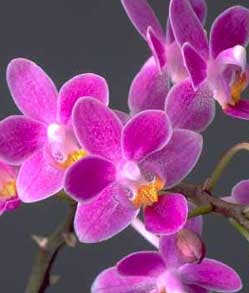
Philippines and Taiwan. One of the most common of the Philippine species in this genus, it is a lovely small-flowered plant which is frequently grown under the name of Phalaenopsis rosea. It was originally described by Schauer in 1843 as Stauroglottis equestris but when specimens were introduced into cultivation by Messrs. Veitch in 1848, it was described as new by Lindley who called it Phalaenopsis rosea. Reichenbach reported the error in 1849 but the misnomer still is used on occasion. A charming plant, the leaves are about six or more inches long, shiny green and notched at the apex. The inflorescence is arching or nearly erect, slightly zigzag and thickened, slowly lengthening and producing flowers for several months. The flowers are one and one-half inches across at most, the sepals and petals broad, pointed and white with purple in the middle, the lip three lobed, light purple with darker purple streaks and a bright yellow two-lobed crest spotted with red. A very bright and attractive species which remains in bloom for months at various times of the year, it is highly recommended for the hobbyist.
Phalaenopsis esmeralda: ( = Phalaenopsis pulcherrima)
Phalaenopsis fasciata
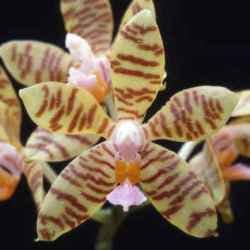
Endemic to the Philippines. Described by Reichenbach in the GARDENERS' CHRONICLE in 1882, it has the plant habit much like that of Phalaenopsis lueddemanniana but the flowers similar to those of Phalaenopsis sumatrana. Unfortunately this species has been lumped into a broadly defined Phal. lueddemanniana for hybrid registration purposes adding confusion to the hybrid records. As a parent, Phal. fasciata transmits strong yellow base color, a red lip and fine pale brown spotting over most of the flower. The yellow base color will fade with time but not as quickly as hybrids made with Phal. mannii and most modern yellow hybrids have Phal. fasciata somewhere in the background.
Phalaenopsis forbesii: ( = Phalaenopsis viridis)
Phalaenopsis fugax: ( = Pteroceras pallidum)
Phalaenopsis fuscata
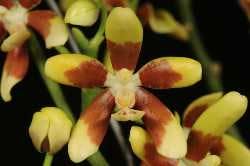
Malaysia, Borneo, Philippines. A rather attractive small-flowered species, it is not widely known or grown. It was originally described by Reichenbach in the GARDENERS' CHRONICLE for 1874, from material supplied by Mr. Bull who had imported plants from either the Philippines or Malaya. The leaves are about twelve inches long and four inches wide, the inflorescence branched and as long as the leaves. The small flowers are pale yellow-green, the sepals and petals slightly stained with chocolate brown near the base. The lip is shorter than the other segments, with short broad side lobes which are white with red-brown markings, and with a flat middle lobe with a central ridge and forked appendage at the base, cream-color with red-brown lines.
Phalaenopsis gigantea
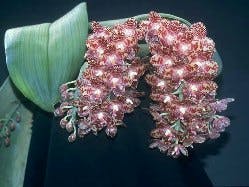
Endemic to Sabah and adjacent Kalimantan Timur. Described by J. J. Smith in 1909, the name applies to the large, fleshy leaves, up to twenty inches long, rather than to the flowers which are about two inches across. From twenty to thirty brown-spotted white flowers are borne closely together on the foot-long inflorescence. Plants take significantly longer to reach flowering size than any other Phalaenopsis species and, as a result, the demand for collected plants continues to be a problem. The huge plant size and pendent inflorescence are both recessive traits when bred to complex tetraploid hybrids. Because of this, Phal. gigantea is used more often than one would expect and it is in the background of Phal. Golden Peoker, the original source of what have become known as harlequin Phals.
Phalaenopsis gloriosa: ( = Phalaenopsis amabilis)
Phalaenopsis grandiflora: ( = Phalaenopsis amabilis)
Phalaenopsis hebe: ( = Phalaenopsis deliciosa subsp. deliciosa)
Phalaenopsis x intermedia
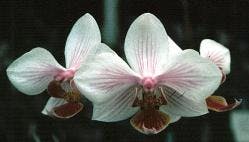
Philippines. A natural hybrid, P. aphrodite X P. equestris. It was also made artificially by John Seden and flowered in 1886. Unlike other natural hybrids in the genus, Phal. x intermedia has formed a genetically stable population that acts like a species and self-reproduces. This natural hybrid is vigorous, typically producing keikis on the apices of the inflorescences after flowering.
Phalaenopsis kunstleri
Myanmar and the Malay Peninsula. Extremely similar to Phal. fuscata and difficult to tell apart without a close examination of the lip callus. This species continues to be rare in cultivation.
Phalaenopsis x leucorrhoda
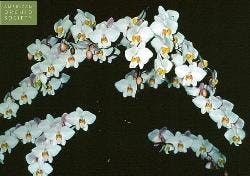
Endemic to the southern Philippines. A natural hybrid between P. aphrodite X P. schilleriana. The flowers vary from nearly white to deep pink, the leaves vary from mostly green to mottled and barred with gray. Unlike the two parents, this hybrid tends to form long, sterile inflorescences if the temperature difference between night and day is consistently too little.
Phalaenopsis lindenii
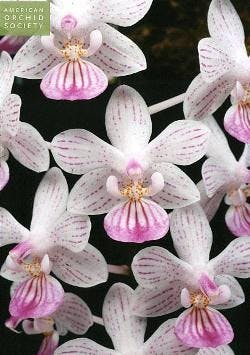
Endemic to the Philippines. Collected and described by Loher in the JOURNAL DES ORCHIDEES in 1895, it was dedicated to M. J. Linden. The leaves have a marbling similar to those of Phalaenopsis schilleriana but are somewhat narrower, the flowers resemble those of Phalaenopsis equestris but are a little larger. The petals and sepals are similar, pink and somewhat narrow, the three-lobed lip is longer than the other segments. The narrow erect side lobes are spotted with red-brown, the middle lobe is broad toward the apex with dark purple lines. This had been considered as a natural hybrid between Phalaenopsis equestris and Phalaenopsis schilleriana, but it is recognized now as a valid species. The flowering season is from March to August, the plants flowering over a long period. This species requires somewhat cooler growing conditions than most species and will languish under consistently warm conditions.
Phalaenopsis lobbii
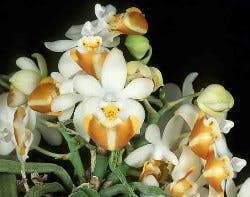
India, Bhutan, Myanmar to Vietnam. This species has often been confused with Phal. parishii however the two species are distinctly different. In addition to flower differences, the leaves of Phal. lobbii are a very dark green while those of Phal. parishii are a distinctly blue-green color.
Phalaenopsis lowii
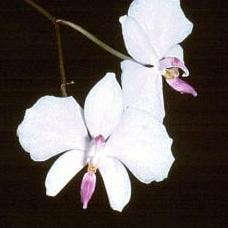
Myanmar to Thailand. Discovered originally by the Rev. C. S. Parish in Moulmein, it was introduced through him by Messrs. Low and Co. in 1862, at which time Reichenbach described it in the BOTANISCHE ZEITUNG. This species is reported to be deciduous, dropping its leaves after flowering, during the severe dry season which follows the season of excessive rain, The deciduous, pointed leaves are from two to four inches long. The inflorescence is up to fifteen inches long, arching, bearing few to many flowers on a branching stem. The flowers can be two inches across, white with purple flush toward the base of the sepals and petals, and deep purple on the middle lobe of the lip. The sepals are elliptic, the petals three times as broad, nearly rhomboidal with the outer margin rounded. The lip has small, hooked side lobes which are erect; the middle lobe is oblong and toothed at the front margin, a two-lobed crest at its base is purple, and the thickened median ridge forms a plate near the apex. The column is curved; the anther has a long hooked beak.
Phalaenopsis lueddemanniana
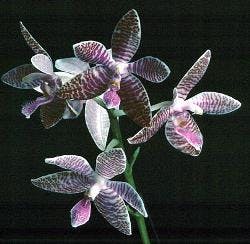
Endemic to the Philippines. Introduced by Messrs. Low and Co. in 1864, it was described by Reichenbach in the BOTANISCHE ZEITUNG for 1865, the name complimenting a well-known Parisian orchidist, M. Liiddemann who first flowered the species in Europe. The few leaves are up to nine inches long, to three and one-half inches broad, the prostrate or trailing inflorescence scarcely longer and bearing up to about seven flowers. The flowers are two inches across and rather variable in color. The sepals are elliptic-oblong, chestnut-brown with pale yellow transverse streaks and margins and a broad purple median band on the basal halves. The petals are smaller than the sepals, amethyst-purple with chestnut-brown spots towards the apex and whitish margins. The three-lobed lip has erect side lobes with a forked callus between, the middle lobe being oblong with a thickened ridge, purple and covered with white bristles. The column is white stained with purple, the anther slightly beaked. This species is variable in size and coloring, as well as in blooming season. It is being used in hybridization to produce a new line of breeding. An attractive species, it is highly recommended to the hobbyist.
Phalaenopsis luteola
Borneo. First described by Burbidge in GARDENS OF THE SUN in 1880, and then formally by Christenson and Gruss, this yellow-flowered species appears to be rare both in nature and in cultivation. It resembles Phal. maculata but the background color is yellow instead of off-white and the lateral sepals are distinctly falcate.
Phalaenopsis maculata
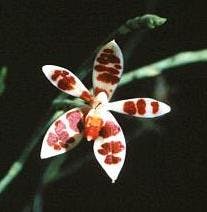
Indonesia and Malaysia. Introduced by Messrs. Veitch in 1880 and described by Reichenbach in the GARDENERS' CHRONICLE for 1881, it is a dwarf species with leaves only four inches long, the few-flowered inflorescence being only slightly longer than the leaves. The flowers are very small, less than three-fourths of an inch across, creamy white with red-brown markings with a bright red middle lobe to the lip. Not commonly cultivated, this species requires moist intermediate conditions and rather heavy shade.
Phalaenopsis mannii
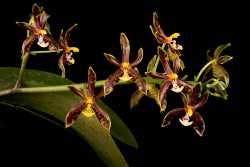
Northeast India, Nepal and China to Vietnam. Discovered by Gustav Mann in 1868, it was described by Reichenbach in the GARDENERS' CHRONICLE for 1871. Somewhat variable in size and coloring, it is from the outer fringe of the Phalaenopsis geographical range. The leaves are up to eight inches long and two inches broad, green spotted with purple at the base. The inflorescence, somewhat branched and a little longer than the leaves, bears up to fifteen or more two-inch flowers. The sepals and petals are golden yellow barred and blotched with chestnut-brown, the lateral sepals being slightly falcate and the petals being a little shorter and narrower than the sepals. The three-lobed lip is shorter than the other segments; the side lobes erect and light yellow, the middle lobe anchor-shaped, light yellow, and saccate at the base. A two-plated crest with cirrhi is between the two side lobes and in front of the crest is an erect purple tooth. The club-shaped column has two protuberances at its base and is golden yellow stained with red. A rare species in cultivation, it has been used in early novelty and yellow hybridizing efforts. However, because the yellow background color fades rapidly, and its narrow, revolute floral segments it has fallen out of favor; replaced by other species with more stable yellow color.
Phalaenopsis mariae
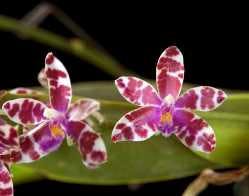
Endemic to the Philippines and Indonesia. First discovered by F. W. Burbidge in 1878, it was illustrated in Williams' ORCHID ALBUM II, t. 80, and was subsequently imported in quantity from Mindanao in the Philippines where it is not uncommon. Resembling Phalaenopsis lueddemanniana in habit, the flowers are smaller, less than one and one-half inches across. The sepals and petals are yellow-white barred chocolate brown and spotted with magenta at the base. The lip is similar to that of Phalaenopsis lueddemanniana, rose-purple with white margins, the central lobe flat and without bristles. It is surprisingly uncommon in cultivation perhaps due to its increased tendency to crown rot.
Phalaenopsis micholitzii
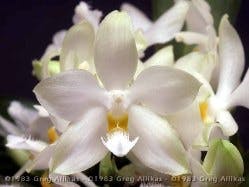
Philippines. Discovered by Micholitz in 1890 and reported in the GARDENERS' CHRONICLE for that year, this species has until rather recently been uncommon in cultivation. It belongs to the same subgenus and section as Phalaenopsis lueddemanniana and to Phalaenopsis mariae but it cannot be mistaken for any other species in the section. The flowers, up to two and one-half inches across, are stark white to yellow-green and completely unmarked by transverse bars. The flowers open singly on the shortest inflorescences in the section, however their length is more than made up for by the number produced. This is a spectacular species for the hobbyist.
Phalaenopsis muscicola: ( = Phalaenopsis maculata)
Phalaenopsis pallens
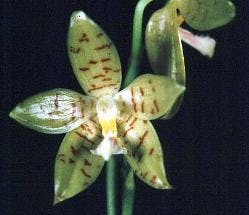
Endemic to the Phillipines. This species, first described by Lindley in 1850 as Trichoglottis pallens was transferred to Phalaenopsis by Reichenbach in 1864. The species is so named in reference to the muted colors of the flowers. The species is closely related to the Phal. lueddemanniana complex but because it lacks the rich pigments of the other species in the complex it has never held much favor in hybridizing. It is however, a strong, easily grown species and will survive with significant neglect.
Phalaenopsis parishii
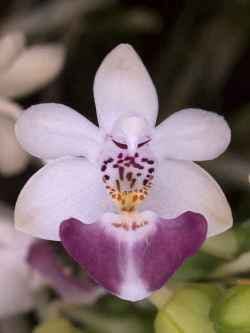
India to Thailand. Introduced by Messrs. Low and Co. through its discoverer, the Rev. C. S. Parish in 1864, it was described by Reichenbach in the BOTANISCHE ZEITUNG for 1865. In its native habitat it is found on branches of trees covered with moss and is subjected to great heat and moisture during its growing season. After it has flowered, the leaves drop off during the subsequent dry season although plants in cultivation may not necessarily drop foliage. It is a small plant with fleshy, flat roots and leaves up to four inches long and gray-green in color. The inflorescence is as long as the leaves, with from five to nine flowers, each flower about three-fourths of an inch across. The sepals and petals are white, the dorsal sepal oblong, the lateral sepals broader and ovate, the petals obovate. The three-lobed lip is movable at the point of attachment, the lateral lobes are small horns bent backwards, yellow spotted with purple, the middle lobe is almost triangular and bright rose-purple. The crest is half-moon shaped with a fimbriate margin, white with a yellow-brown center. The motile lip is unusual for this genus and underscores the difficulty of finding characters that are consistent for generic definition. A gem for the collector.
Phalaenopsis portei. ( = Phalaenopsis x intermedia var. portei)br Phalaenopsis proboscidioides: ( = Phalaenopsis lowii)
Phalaenopsis pulcherrima
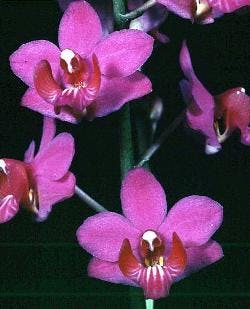
Widespread from India to Vietnam, Malaysia, Indonesia and Sabah. This distinct species, not always considered a member of this genus, was first described by Lindley in his GENERA AND SPECIES OF ORCHIDACEOUS PLANTS in 1833 as Doritis pulcherrima, basing his account on a dried specimen collected by Finlayson in Cochin China and preserved in the Herbarium of the East India Company. The material was fragmentary and for nearly a hundred years no other specimens appeared to have been collected. Meanwhile, in 1874, M. Godefroy introduced from the same general area some plants which Reichenbach described in the GARDENERS' CHRONICLE as Phalaenopsis esmeralda that year. Later, at intervals, Reichenbach described three other orchids as Phalaenopsis antennifera, Phalaenopsis regnieriana and Phalaenopsis buyssonniana. The former remains a synonym of Phalaenopsis pulcherrima while the latter two are now recognized as distinct species. It was not until 1917 that Robert Allen Rolfe by chance came across an old watercolor of Lindley's Doritis pulcherrima which bore the original collector's number of Finlayson. It was clear that this was the same as Reichenbach's Phalaenopsis esmeralda and, since it had priority as well as sufficient differences to be retained as a separate genus, the name Doritis pulcherrima was accepted. Other species which had been put in the genus Doritis were removed by Rolfe and placed in a new genus Kingiella (see ORCHID REVIEW, September, 1917, page 195). In 1933, J. J. Smith returned this species to Phalaenopsis, retaining the specific name that had priority. There is no doubt that this species differs considerably from the typical Phalaenopsis, but its inclusion in this genus seems to be more rational taxonomy than to set up a separate genus for one species. The oblong, pointed leaves are up to eight inches long. The inflorescence is slender, erect, up to twenty inches high, bearing many flowers. The one-inch flowers are arranged spirally around the rachis. The sepals and petals vary from amethyst-purple to nearly white and are somewhat reflexed. The lip is three lobed, the lateral lobes rounded and erect, varying in color from deep purple to pale mauve and even orange-red to brownish red. The middle lobe is deep purple, oblong and pointed, with a bilamellate crest behind which are two cirrhi-like lobes. The column is slender, the anther is beaked. The two broad antennae at the base of the lip instead of at the apex distinguish this species from all others and constitute one of the reasons for placing it in another genus. Further, the base of the lip is rather deeply saccate, another unusual feature. An attractive species, now seen fairly frequently in collections, it is a delightful plant for the hobbyist.
Phalaenopsis rimestadiana: ( = Phalaenopsis amabilis var. rimestadiana)
Phalaenopsis rosea: ( = Phalaenopsis equestris)
Phalaenopsis rosenstromii: (= Phalaenopsis amabilis<. /> subsp. rosenstromii)
Phalaenopsis ruckeri: ( = Pteroceras unguiculatum)
Phalaenopsis schilleriana
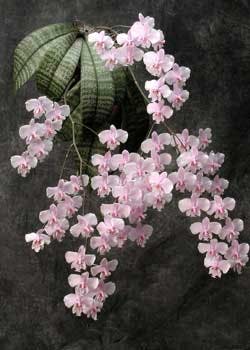
Endemic to the Philippines. Introduced from Manila in 1858 by Consul Schiller, of Hamburg, in whose collection it first flowered in 1860, it was described and dedicated to him by Reichenbach in the HAMBURGER GARTENZEITUNG in 1860. Since its introduction, it has been highly esteemed by orchid growers and is one of the most widely grown of the species. The elliptic-oblong leaves, usually few in number, are large, up to fifteen or more inches long and nearly five inches broad, deep dull green which is marbled and transversely barred in irregular patterns of gray. The inflorescence frequently extends to three or four feet, loosely branches and bears very many flowers. The flowers are three to three and one-half inches across or less when many flowers are carried. The sepals and petals are rose-purple suffused with white, the lateral sepals finely dotted with purple on the inner basal half. The lip is white or pale rose-purple stained with yellow at the base and spotted with red, the front lobe dotted with purple. The sepals are elliptic-oblong, the petals nearly rhomboid and twice as broad as the sepals. The three-lobed lip has a long narrow claw, the side lobes are round and curved upward, the front lobe broadly trowel-shaped with the apex forking into two appendages like the flukes of an anchor. This species has been widely used in hybridizing, is grown widely for its masses of flowers and has a rightful place among the loveliest of the orchids. It flowers in winter and spring.
Phalaenopsis speciosa
Endemic to Andaman and Nicobar Islands (India). Discovered by Major General E. S. Berkeley and introduced by him in 1881, it was described the same year by Reichenbach in the GARDENERS' CHRONICLE as Phalaenopsis spciosa. The bright green leaves are a foot long and about three inches broad. The drooping inflorescence, longer than the leaves, sometimes branches and bears from nine to twelve flowers, each two inches across. The sepals and petals are spreading and stellate, amethyst-purple with a white margin, the lateral sepals slightly larger and furnished with a yellowish point, the petals are slightly narrower than the dorsal sepal and pointed. The lip is shorter than the other segments, three lobed, with the side lobes erect and truncated, the middle lobe fleshy, oblong and furnished with a pubescent keel above, and amethyst-purple. An orange-yellow crest is between the two side lobes. This is one of the handsomest of the species in the Subgenus Polychilos Section Zebrinae, but it does not seem to have remained in cultivation in the 20th century. It flowers in the winter.
Phalaenopsis stuartiana
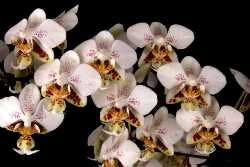
Endemic to the island of Mindanao, the Philippines. This species was discovered in 1881 by Boxall while collecting for Stuart Low and Co., and Reichenbach named it for the former head of the firm when he described it in GARDENERS' CHRONICLE for that year. It is frequently found along the seashore. The leaves are up to a foot long and to four inches broad, the upper surfaces marked with transverse gray blotches that disappear in age, the undersides being purplish red. The arching inflorescence varies in length, is usually branched and bears many flowers. The flowers vary from one and one-half inches to nearly three inches, and are mostly white with pale yellow on the basal half of the lateral sepals and heavy red-purple spotting on the inner half. The petals are much larger than the sepals, nearly rhomboidal, white with a few scattered dots of purple towards the base. The lip is three lobed with a short, thick golden yellow crest that divides into two lobes. The side lobes of the lip are obliquely oblong, the basal portions yellow and spotted with red-purple; the middle lobe is nearly rhomboidal with two anchor-like lobes at the apex, light yellow spotted with red-purple. A highly variable species, there are numerous named varieties based mostly on the spotting. A fine species, it is related to Phal. schilleriana.
Phalaenopsis sumatrana
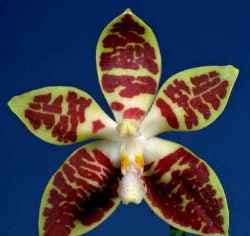
Widespread from Myanmar throughout Indochina to Indonesia, Malaysia and the Philippines. The original type drawn by the Dutch naturalist, Dr. Korthals, actually represents Phal. inscriptiosinensis and that has lead to much confusion. Adding to the confusion was a plant found by Teijsman in 1859, and sent by him to the University of Leyden under the name of Phalaenopsis zebrina where it flowered there in 1861. The concept of Phalaenopsis zebrina is indeed synonymous with Phal. sumatrana. Both Phal. sumatrana and corningiana are characterized by a tuft of hairs on the lip midlobe while the midlobe of Phal. inscriptiosinensis is devoid of hairs. Phal. sumatrana is a handsome species with short, nearly erect inflorescences, it is rather variable and several forms have been named. The two-inch flowers are yellowish white barred with brown, the petals being slightly narrower than the sepals. The lip is three lobed, the side lobes being erect and truncate, the middle lobe being fleshy with a prominent keel and a tuft of hairs on each side of the crest. This species usually flowers in May and June.
Phalaenopsis x veitchiana
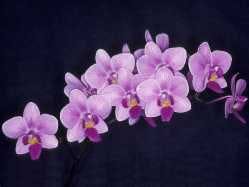
Endemic to the Philippines. A natural hybrid, P. schilleriana X P. equestris. This natural hybrid has been recreated artificially and the results are fully consistent with the presumed parentage of the natural hybrid. Plants produce copious numbers of flowers during the spring months.
Phalaenopsis violacea
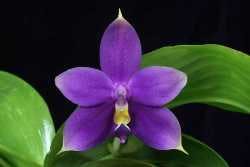
Sumatra and the Malay Peninsula. Discovered by Teijsman in Sumatra in 1859, it first flowered in the Botanic Garden at Leiden in 1860. It is a distinctive species with bright green leaves up to nine inches long and four inches broad. The inflorescence is short, stout and slightly zigzag, the two to five or more flowers appear in succession. The flowers two to three inches across. Unlike the closely related Phal. bellina, the flowers of Phal. violacea are typically a rather nondescript rose-purple. Because of the lack of separation between the two species many of the improved strains in cultivation are most likely interspecific hybrids. The two species can be distinguished by fragrance; Phal. bellina being candy-like and Phal. violacea is more spicy.
Phalaenopsis viridis: ( = Phalaenopsis fuscata)
Phalaenopsis wightii: ( = Phalaenopsis deliciosa subsp. deliciosa)
Phalaenopsis zebrina: ( = Phalaenopsis sumatrana)








